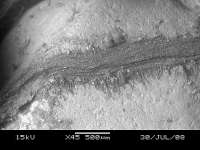From: ted.held at us.henkel.com (ted.held at us.henkel.com) on 2008.08.08 at 18:40:49(18351)

People might remember a month or so back when Peter Boyce spoke of an
Asian aroid that attached itself by roots to rock ledges. Well, I didn't
have material from that plant, but the common aquatic genus Anubias also
has roots that affix themselves tightly to substrate pebbles. Above is a
picture of one of these roots that I took with a scanning electron
microscope (SEM). You can see the little hair-like structures, that are
probably responsible for doing the attachment, emanating from the main
root. The bond is quite strong and detaching the root requires that it be
broken and torn. The root is attached here to piece of ordinary "pea"
gravel. Because an SEM requires high vacuum, many plant parts become
desiccated and withered as you look at them, as has happened to the main
root here. That is why the center root skin shows the outline of
individual cells. In life the root would be fuller. Fortunately for this
investigation these tissues contain enough cellulose to indicate the
structure despite being dry. For reference, the little measuring bar in
the center is 500 microns wide, 0.5 millimeters.
By the way, if you are in Miami this September for the IAS show, I plan on
presenting an informal workshop talk on Cryptocoryne, an Asian aquatic
aroid genus that does not form roots that affix to rock. But I think I'll
include more pictures of this same root in the presentation because there
are a number of small organisms living on this tissue and they were a
source of amazement for me when I saw them under the SEM. When you look at
things really close it is fun to find that the world is filled with life
forms that we are not even aware of, merrily living their lives not caring
about either Republicans or Democrats.
I have sent some SEM pictures of the little beasts (my guess is that they
are diatoms, but they are not the usual symmetric forms that you always
see in the textbooks) to Christopher Rogers, our resident invertebrate
specialist on this list, for identification. We'll see if he comes up with
the answer by September. Come to the show to find out.
Ted.
| +More |



